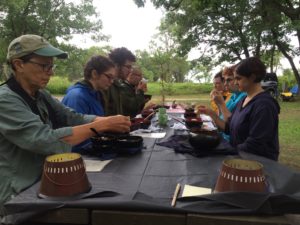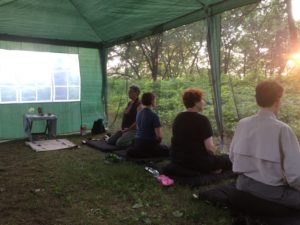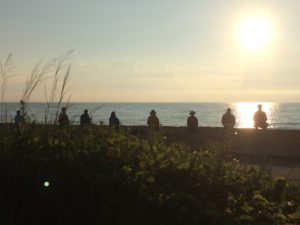Reflections on a Branching Streams Fellowship
Through the Branching Streams Fellowship Program, Hakusho Johan Ostlund was invited to spend six months with Taigen Dan Leighton and the Ancient Dragon Zen Gate Sangha (ADZG) in Chicago. Hakusho, Taigen, and Ino Laurel Ross share their appreciation and experiences.
(continue reading from home page)

Hakusho Johan Ostlund Fellowship Priest
Hakusho, originally from Sweden, began practicing in 2003. Just prior to joining the San Francisco Zen Center (SFZC) community as a farm apprentice at Green Gulch Farm in 2006, he spent nine months in India and Thailand, mostly within Tibetan Buddhist and Theravada communities. Aside from a departure of a little more than a year in 2009-2010, he has been in residence since 2006. Hakusho filled the position of shuso (head student) at the Spring 2016 Tassajara Practice Period.
My Fellowship at Ancient Dragon Zen Gate
By Hakusho Johan Ostlund
Pilgrimage: part of our tradition
The history of Zen Buddhism is filled with stories of teachers sending students out to study with other teachers and sanghas, allowing them to experience different views on the Buddhadharma. This practice of pilgrimage is part of our tradition.
At SFZC, it has been fairly common for our Branching Streams Sanghas to send students to one of our temples, but it’s been much less common for students and teachers-in-residence at SFZC to practice with affiliate sanghas for a period of time.
In recognition of this potential mutual benefit, SFZC instituted the Branching Streams Fellowship program. Emerging teachers are sent to affiliate sanghas to learn from them and receive valuable teaching experience; affiliate sanghas are enriched when joined by practitioners with extensive residential training and no other significant commitments.
Six months in Chicago
With this in mind, I was quite thrilled to be invited to practice as the residential teacher for a period of six months at ADZG in Chicago with Taigen Dan Leighton. After nine years in residence at one of the three temples of SFZC (the bulk of it at Green Gulch Farm), and in my case, never having lived anywhere else in this country, this was an opportunity to experience something new, to have my eyes opened to both living American Zen, and this country in which I’ve now spent almost a decade.
Arriving in a city I’d never been to before and where I didn’t really know anyone, one of my first impressions was that of being welcomed as family while arriving a stranger. The ADZG Sangha took very good care for my arrival: a room to live in at a sangha member’s apartment, pick up as I arrived, transit travel card, cell phone, and an assigned seat in the zendo. But beyond the logistical arrangements, it was that feeling of being greeted as a distant relative that warmed me most and helped with settling.
If that was the first impression, the second one was for sure that Ancient Dragon is a very different beast than the Green Dragon, the name we give to Green Gulch when talking about it as a temple. I’m deeply familiar with all the work involved in running Green Gulch, but from the perspective of Ancient Dragon, where everybody but Taigen is a volunteer with a whole “normal life” to maintain in addition to temple duties, I found a new appreciation for the incredible people power and resources we have available at SFZC.
I was also very touched and often inspired to hear about the juggling and struggling that many ADZG members voiced regarding the challenge of carrying out their practice in environments that didn’t seem to encourage it. Another significant observation for me was that at any given Dharma event, everyone present was there because they wanted to be there and had made a real effort to get themselves there.
Roles, responsibilities, and the gift of being present

My responsibilities, beyond following the full zendo schedule, consisted of conducting training for priests and laypeople performing services and doan jobs, oryoki training, as well as serving as an assistant to Taigen. This could include anything from assisting in answering some of the many Dharma questions that got sent his way, or acting as ino or tenzo when needed, to showing up to let the HVAC technician in to repair the air conditioner when it broke down during the height of summer.
In addition to this, I was also invited to give several Dharma talks and a couple of seminars, as well as to co-lead a weekly sitting with discussions of Suzuki Roshi’s teachings. This was a great opportunity for me to gain more teaching experience than I would have had if I’d remained at SFZC during this time. I was also sitting in on board and fundraising committee meetings, which provided me with a better view into the workings of a small, nonresidential sangha and all that’s involved in keeping a place like Ancient Dragon going.
But the most unique and meaningful experiences that I had were my visits with a dying Sangha member. Twice a week I would sit with Daniel, a person with congestive heart failure and only a few more months left to live. To show up in his room with nothing to offer other than a smile and my presence made me all the more intent to do so completely. In response, I got to learn about another person’s life in a way I could never have done otherwise. When he passed six weeks later, I then had the honor of helping to create and perform his memorial service.
Encouraging your own pilgrimage
So while my six-month fellowship position was a very eye-opening experience for me, was I able to benefit the sangha through my presence in a way that will continue now when I’ve left? I don’t know. I hope so. To my ears, the services we performed during the last sesshin we sat just before I left were carried out with more energy and cohesion than the first one we sat not so long after I had arrived. Some forms have been clarified, others remain a mystery.
For me personally, if I get to see someone from Ancient Dragon who has not already practiced at any of SFZC’s three temples take some time out to do that, whether it’s a week, a few months, or an indefinite period of time, this is probably what will gladden me the most. If my practice at Ancient Dragon has inspired anyone to try to put their “normal life” on hold to practice residentially or monastically, I just might through my presence have been able to convey some of what this practice has offered me and what I believe it has to offer others.

Taigen Dan Leighton, Guiding Dharma Teacher
Hakusho’s visit was a great help to me personally and was helpful to Ancient Dragon in many ways. Hakusho assisted in various capacities and stepped in when I was unavailable. He particularly helped with our zendo forms and assisted our Ino, as she describes below. As I had hoped when requesting the fellowship, Hakusho’s regular presence in the zendo as a well-trained priest supported the tone of our sangha’s practice. He worked very helpfully with the doans and our priests, and the effects have lasted since his departure. While our chanting practice and zendo forms are not the equivalents of a residential center like Green Gulch, and as a non-residential lay storefront temple they are never likely to be so, our chanting is surely stronger than it had been. I also believe our sangha is more receptive now to hearing ino announcements to clarify and strengthen zendo forms.
Specific lasting differences that have resulted at least in large part from Hakusho’s sojourn is that our doans are now taking very good care of regular chidening and candle trimming, two functions that I had done almost exclusively by myself previously. They are also taking on more responsibility for opening and closing the temple. All of this is a great relief for me. The model from Hakusho of someone whose position includes helping assist me in administrative tasks is also a useful precedent. This will in some fashion apply for the new position for our former tenzo, although probably in particular ways varying from the tasks Hakusho fulfilled. I feel overall more supported as a teacher than previously, thanks to the experience of this fellowship.
As to Hakusho’s fulfillment of the fellowship personally, his warmth, sincerity, and friendliness endeared him to our sangha. I appreciated that he extended himself to develop good relationships with our many sangha members, both in and out of formal temple contexts. His talks and seminars were also well appreciated, and his presentation style evolved and developed nicely during the fellowship. This reflects the difference in opportunity to practice skills between SFZC as a large training center with many teachers where priests only give talks after being shuso, versus a smaller, more informal sangha like ADZG, where I have invited selected sangha participants to give Dharma talks.
Quite aside from Hakusho’s admirable personal qualities and genuineness that were helpful to the success of this fellowship experience, I conclude that this program of bringing an experienced priest was very helpful to our sangha, and hope that Branching Streams will continue it at other appropriate venues. In terms of the relationship of Branching Streams affiliates to SFZC home temples, with my encouragement over some years a number of Ancient Dragon students have benefited by spending time either at Green Gulch January intensives, at Tassajara or Green Gulch practice periods, or in shorter visits. I expect such visits to continue. But I would be very happy if one result of this Branching Streams Fellowship and Hakusho’s experience would be to inspire SFZC trained priests and new teachers to go out and spend time at smaller sanghas, both for their own training and to support smaller sanghas. I know of a few small sitting groups around the country started from the Suzuki Roshi lineage where teachers and priests are needed.

Gyoshin Laurel Ross, ADZG Ino
Ancient Dragon Sangha was honored and delighted to host Hakusho as a visiting priest for six months in 2016 and are grateful to the Branching Streams Fellowship program for supporting this experience. Our sangha benefited in myriad ways from Hakusho’s generous presence in the zendo and beyond.
Our hope and expectations revolved around having him provide much-needed support for Taigen, helping us to refine our forms, and connecting us to the broader Branching Streams Sangha. Hakusho found many ways beyond these initial requests to participate and inspire us.
He was a solid presence in the zendo for six months at the many sittings, classes, and services we provide. The ino and the tenzo both appreciated his contributions. His low key and consistent coaching was received well by the priests and senior students and resulted in considerable improvement in the performance of forms that has continued after his departure. He too may have benefited from this experience from recognizing the sincerity that shone through, even when the forms were imperfect.

Among the highlights of Hakusho’s tenure at Ancient Dragon was a four-day “camping sesshin” which greatly benefited from his presence. This was the first time the sangha organized a camping experience and much of the format was trial and error. Success depended on the hard work and nimbleness of the leaders who adapted willingly to challenging situations. Hakusho was extremely helpful in such practical matters as replacing the duct tape on the outdoor “zendo” multiple times daily, but also in presenting a model for smiling while solving problems. The camping sesshin was a great success and will be repeated this year with many improvements.
During his first month in Chicago, Hakusho commented on his realization that it takes a lot of time to attend to the daily needs of living (meals, apartment, travel, etc.) when one is not in a residential practice where everything is provided. He said it brought him a new appreciation for the luxuries of monastic practice.
Hakusho’s fresh perspective was always welcome at Ancient Dragon. His youthful yet serious outlook on Zen practice brought different insights to our discussions and encouraged a number of students to consider visits to Green Gulch Farm and other residential possibilities.

________
